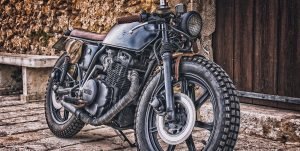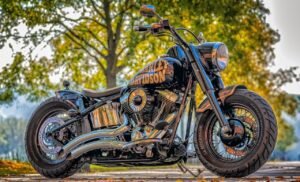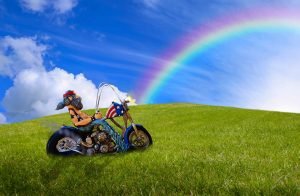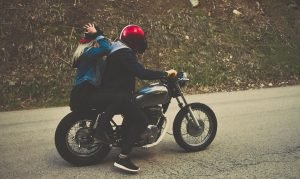How to not die on a motorcycle
Updated on | By Mohit Chauhan

We have been riding motorcycles for several years and have helped many friends on our extreme motorcycle tour to get along. During this time we cumulated bunch of tips that can help a rider to learn the basics while riding a motorcycle.
Being careful does not mean being fearful or riding at a really low pace, it is simply about anticipating what may happen. On the road, you are not the king of the world; a fatal motorcycle accident is 22 times more likely to occur than a fatal car accident. If you too were taught at MSF that motorcyclists are often killed when they are alone, on open roads and in good weather, you have not been lied to.
In fact, a fatal motorcycle accident occurs outside urban areas in 69% of cases (including 8% on highways). In other words: more than 2 out of 3 fatal motorcycle accidents take place outside the urban area! This is considerable!
Outside urban areas, 42% of motorcyclists are killed on curves where the information about the bends is given. In urban areas, 44% of fatal motorcycle accidents occur in an intersection. You can’t let this happen to yourself.
So make yourself visible, anticipate and adapt your speed in all situations. These figures and all those that follow urge us to do our best to ensure that all bikers ride with caution.
In today’s blog, we are going to share the all-important methodologies that should be kept in mind by any motorcyclist, if he is planning to not die while riding a motorcycle.
Things you need to follow to avoid dying on a motorcycle
Want to reduce your chances of dying on a motorcycle? The first thing you need to do is join a motorcycle safety foundation class. There are many riding skills that a motorcycle school will teach you on a bike. There are courses for beginners who are riding a motorcycle for the first time. There are also specialized courses for extreme riding and for racing on the tracks.
Don’t be intimidated by the prices; you can always find a good school at a reasonable price.
Also, make sure that you do not forget to wear basic motorcycle equipment and gear. Not only can these save your life, but they will also make it easier for you to ride a motorcycle. Among other things, bright clothes and reflective tapes will help other vehicles to see you on the road, which will also help to avoid a collision.
Make sure you keep these things in mind if you do not want to die while riding a motorcycle:
Driving Experience
Before getting behind the wheel of a motorcycle, it is worth acquiring an active experience of driving a car, at least the initial two years after obtaining a license. This will allow you to learn how to read the traffic flow, predict an unforeseen circumstance, and to anticipate the intentions of other drivers. With these skills, it will be much easier for you to focus on the road.
Motorcycle School
Choose a motorcycle school which has the most individual approach to training. One instructor should have no more than two students at a time. Besides, the training site should not be crowded with spectators and there should not be any kind of queue to ride a motorcycle.
It would be best if the motorcycle school provides additional skills beyond those required for the exam. Many schools also provide emergency trainings in case of an accident and the option to train on more powerful bikes, be sure to take advantage of this.
Advice: Analyze your riding instructor; a “cool guy” will not necessarily be a good teacher. If a person brags about how he “drove 200 km/h in the opposite lane” – run from such a person, he will not teach you anything good. If you have friends or acquaintances who are motorcyclists, ask them for a school recommendation.
Choosing Motorcycle
After passing the exam, you will need to decide your first beginner motorcycle. The topic is very contentious and there are no simple answers to it. But since we are subjective here, here are some of our recommendations:
- Engine displacement up to 400 cm3
- A minimum of plastic body kit (it is quite common for beginners to drop their first motorcycles)
- The most recent year of production (that you can afford)
Do not get obsessed with the type of motorcycle; classic, cruiser, sport, naked, etc. as normally the first motorcycle is purchased for a couple of seasons, before you can jump on to more advanced powerful bikes. Our recommendations include: Duke 200, Duke 390, and G310GS
Motorcycle Gear
There is no such thing as most important or less important motorcycle gear. While setting aside a budget for your motorcycle, make sure you have included the cost of equipment and gear as well. Motorcycle gear includes:
- Helmet: It is highly recommended to purchase an integral full face helmet. Also, the helmet must be certified, at least with DOT (best if ECE approved) and should have a Pinlock visor insert. (Suggested read: Best beginner motorcycle helmets)
- Motorcycle Jacket: Your back, shoulders and elbows should be protected. Again, the protective jacket must be certified. Look carefully before buying; there should be a full-fledged protective insert, and not a piece of a mat that usually can be found on cheap quality products.
- Trousers: Its simple here; knee protectors and optional thigh protectors.
- Gloves: Riding gloves made of thick leather or modern textile materials will protect your hands from abrasion on the asphalt.
- Motorcycle Boots: Riding boots must have a rigid sole and should protect your toes and heels. It is best if you opt for ankle high boots since your legs are the first to take the blow in case of a crash.
Tuning-up Riding Skills
You are all geared up and ready to roll, but now is the time to get used to your bike. We recommend getting out later in the evening, when the traffic flow is minimal and there are relatively less pedestrians. Ride through your typical daily routes and work on your reflexes. Get used to the position of the seat, the handle bar, the consoles, and most importantly, the brakes. Practice maneuvering at low and medium speeds, which will greatly improve your skills. Also, learn the techniques of parking on a side stand, center stand, and swerving at the last moment (very important).
With these basic techniques, your riding style will automatically become bolder. But remember one thing; motorcyclists are in a vulnerable position in the event of an accident, so while riding you need to be focused to avoid any exposure to unwanted hazards. What may look like a minor scratch on the bumper of a car might turn out to be an acute fracture for a motorcyclist.
Bottom Line
Under no circumstances should a motorcyclist consider a public road a race track to test the performance of his motorcycle. Besides, a motorcyclist is not a privileged road user than a car or bus driver. It is not mandatory for the vehicles to switch lanes to make room for the accelerating biker behind.
However, if the driver really does behave this way, it is good to thank him for it with a nod or a raised hand. Always signal your intentions to switch lanes and make sure that no one behind you is trying to perform a similar maneuver. Lastly, wear your protective gears before hopping on your machine and stay away from motorcycle myths!





